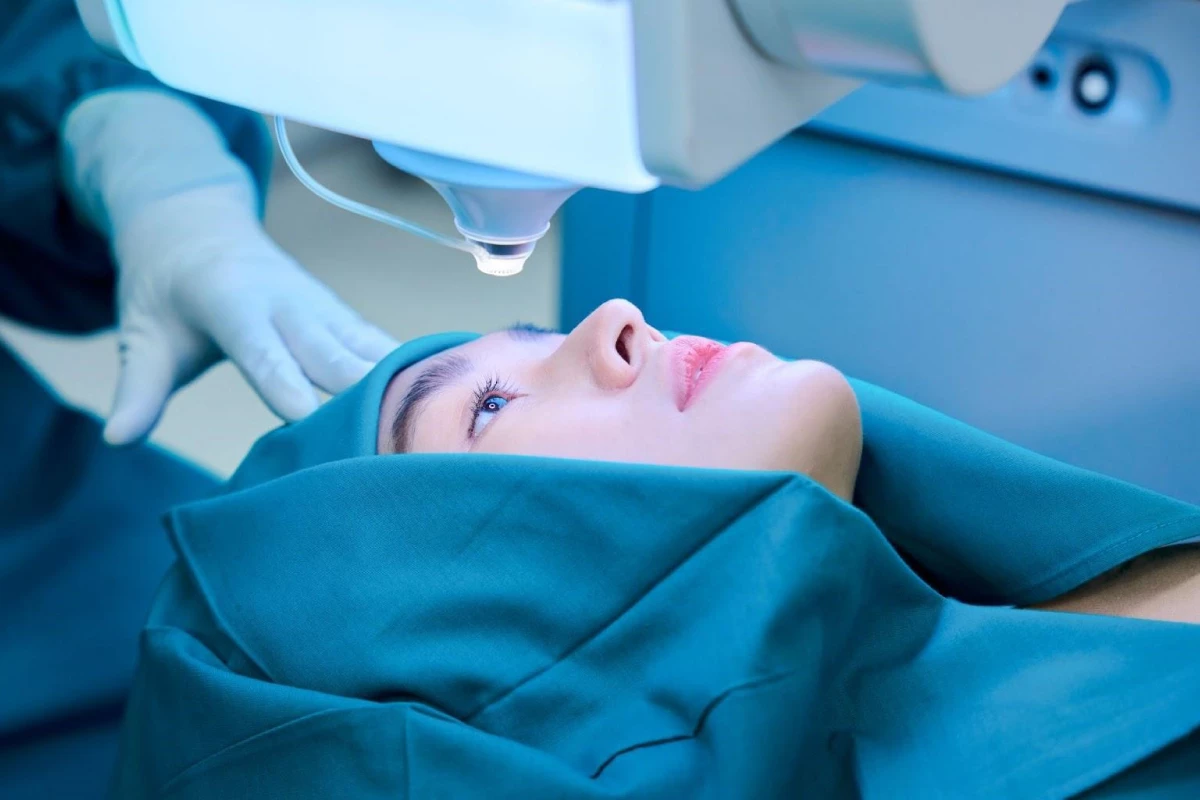For decades, people who wanted to see clearly without glasses or contact lenses turned to LASIK. But as technology advanced, a new option emerged — one that is even gentler, faster, and less invasive. It's called SMILE, short for Small Incision Lenticule Extraction, and it represents one of the most important FDA-approved advancements in laser vision correction.
At Khanna Vision Institute, Dr. Rajesh Khanna offers SMILE as a safe and precise solution for patients who want permanent vision correction with minimal downtime. In this article, we'll explore what SMILE is, how it works, and why it's quickly becoming the procedure of choice for many people.

1. What Is SMILE Vision Correction
SMILE is a laser eye surgery that corrects nearsightedness (myopia) and astigmatism through a very small incision — typically about 2 to 3 millimeters wide. Unlike LASIK, which requires creating a flap in the cornea, SMILE reshapes the cornea internally through this small opening.
The procedure uses an advanced femtosecond laser to create a thin, disc-shaped piece of tissue (called a lenticule) inside the cornea. The surgeon then removes this lenticule through the tiny incision, allowing the cornea to adopt a new shape that focuses light correctly on the retina.
The result is clear, natural vision without the need for glasses or contact lenses.
2. FDA Approval and Clinical Confidence
The U.S. Food and Drug Administration (FDA) approved SMILE for correcting nearsightedness in 2016 and for astigmatism in 2018 after years of clinical trials and research. These approvals confirmed its safety, accuracy, and effectiveness as a mainstream vision correction option.
Today, millions of procedures have been performed globally, and the results consistently show excellent visual outcomes and patient satisfaction.
At Khanna Vision Institute, SMILE is performed using the ZEISS VisuMax laser system, which is known for its precision, speed, and gentleness.
3. How SMILE Differs from LASIK
Both LASIK and SMILE are advanced laser vision correction procedures, but they differ in how they reshape the cornea.
| Feature | SMILE | LASIK |
|---|---|---|
| Type of Laser | Femtosecond laser only | Femtosecond and excimer lasers |
| Incision Size | About 2–3 mm | About 20 mm |
| Corneal Flap | None | Yes |
| Dry Eye Risk | Lower | Slightly higher |
| Healing Time | 1–2 days | 2–3 days |
| Ideal for | Active lifestyle, moderate to high myopia | Broad range of refractive errors |
In short, SMILE offers all the benefits of LASIK but with a smaller incision, less dryness, and greater corneal stability.
4. Step-by-Step: How SMILE Works
At Khanna Vision Institute, the SMILE procedure is simple and comfortable:
- Preparation: Eye drops are used to numb the eye.
- Laser Creation: The femtosecond laser creates the lenticule inside the cornea and a tiny incision on its surface.
- Lenticule Removal: Dr. Khanna gently removes the lenticule through the small opening, reshaping the cornea.
- Healing: Because there's no flap, the cornea heals naturally and quickly without stitches.
The entire process takes less than 15 minutes for both eyes. Most patients notice clearer vision within a day.

5. Who Is a Good Candidate for SMILE
You may be a good candidate for SMILE if you:
- Are 18 years or older
- Have a stable prescription for at least one year
- Have mild to moderate nearsightedness (up to -10.00 diopters)
- Have astigmatism (up to -3.00 diopters)
- Want a flap-free procedure with fast recovery
People with thin corneas or dry eyes who are not suitable for LASIK may also benefit from SMILE.
Dr. Khanna performs detailed diagnostic tests to confirm eligibility and ensure the best results for every patient.
6. Benefits of SMILE Vision Correction
SMILE provides several advantages that make it one of the most advanced and comfortable forms of laser eye surgery available today.
Flap-Free and Minimally Invasive
No corneal flap means less risk of complications and a faster, more stable recovery.
Reduced Dryness and Discomfort
Since fewer nerves are affected, dry eye symptoms after SMILE are minimal.
Quick Recovery and Immediate Results
Most patients can return to normal activities within a day or two, with vision improving rapidly.
Long-Term Stability
The cornea retains more of its natural strength and shape, reducing the risk of future vision changes.
Great for Active Lifestyles
SMILE is ideal for athletes, military personnel, and people who participate in high-movement activities.
7. Safety and Success Rates
SMILE has one of the highest safety profiles among all vision correction surgeries. Clinical studies show:
- Over 98 percent of patients achieve 20/25 vision or better
- Minimal risk of complications
- Excellent long-term vision stability
At Khanna Vision Institute, each SMILE procedure is customized using corneal topography and wavefront analysis, ensuring precise and predictable results.
8. Why Choose Khanna Vision Institute for SMILE
Dr. Rajesh Khanna is a board-certified ophthalmologist with extensive experience in refractive surgery. His expertise, combined with the institute's state-of-the-art technology, provides patients with safe, personalized care.
Khanna Vision Institute stands out for:
- Advanced ZEISS VisuMax laser system
- Personalized evaluations and honest recommendations
- Focus on long-term eye health and comfort
- Transparent communication and patient education
Every procedure is guided by Dr. Khanna's commitment to precision, safety, and natural vision outcomes.
The SMILE laser vision correction procedure is one of the most advanced and patient-friendly options available today. With FDA approval, proven safety, and outstanding visual outcomes, it represents the next step in refractive surgery technology.
If you want clearer, more natural vision without glasses or contact lenses, schedule a consultation with Dr. Rajesh Khanna at Khanna Vision Institute. Together, you can explore whether SMILE is the right choice for your eyes and lifestyle.
